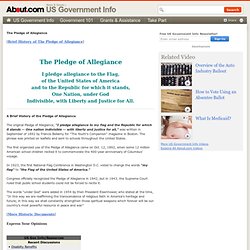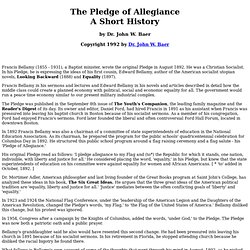

Pledge of Allegiance. The Pledge of Allegiance of the United States is an expression of fealty to the federal flag and the republic of the United States of America, originally composed by Francis Bellamy in 1892 and formally adopted by Congress as the pledge in 1942.[1] The official name of The Pledge of Allegiance was adopted in 1945.

The last change in language came on Flag Day 1954 when the words "under God" were added.[2] According to the United States Flag Code, the Pledge of Allegiance reads:[3] I pledge allegiance to the Flag of the United States of America, and to the Republic for which it stands, one Nation under God, indivisible, with liberty and justice for all. According to the Flag Code, the Pledge "should be rendered by standing at attention facing the flag with the right hand over the heart. When not in uniform men should remove any non-religious headdress with their right hand and hold it at the left shoulder, the hand being over the heart. Origins[edit] Bellamy's account[edit] Changes[edit] The Pledge of Allegiance. [Brief History of The Pledge of Allegiance] The Pledge of Allegiance I pledge allegiance to the Flag,of the United States of Americaand to the Republic for which it stands,One Nation, under GodIndivisible, with Liberty and Justice for All.

A Brief History of the Pledge of Allegiance The original Pledge of Allegiance, "I pledge allegiance to my flag and the Republic for which it stands -- One nation indivisible -- with liberty and justice for all," was written in September of 1892 by Francis Bellamy for "The Youth's Companion" magazine in Boston. The phrase was printed on leaflets and sent to schools throughout the United States. The first organized use of the Pledge of Allegiance came on Oct. 12, 1892, when some 12 million American school children recited it to commemorate the 400-year anniversary of Columbus' voyage. In 1923, the first National Flag Conference in Washington D.C. voted to change the words "my flag" to "the Flag of the United States of America.
" [More Historic Documents] Brief history of the Pledge of Allegiance. The original Pledge of Allegiance, "I pledge allegiance to my flag and the Republic for which it stands -- One nation indivisible -- with liberty and justice for all," was written in September of 1892 by Francis Bellamy for "The Youth's Companion" magazine in Boston.

The phrase was printed on leaflets and sent to schools throughout the United States. The first organized use of the Pledge of Allegiance came on Oct. 12, 1892, when some 12 million American school children recited it to commemorate the 400-year anniversary of Columbus' voyage. In 1923, the first National Flag Conference in Washington D.C. voted to change the words "my flag" to "the Flag of the United States of America. " Congress officially recognized the Pledge of Allegiance in 1942, but in 1943, the Supreme Court ruled that public school students could not be forced to recite it. The Pledge of Allegiance - A Short History.
Francis Bellamy (1855 - 1931), a Baptist minister, wrote the original Pledge in August 1892.

He was a Christian Socialist. In his Pledge, he is expressing the ideas of his first cousin, Edward Bellamy, author of the American socialist utopian novels, Looking Backward (1888) and Equality (1897). Francis Bellamy in his sermons and lectures and Edward Bellamy in his novels and articles described in detail how the middle class could create a planned economy with political, social and economic equality for all. The government would run a peace time economy similar to our present military industrial complex. The Pledge was published in the September 8th issue of The Youth's Companion, the leading family magazine and the Reader's Digest of its day.
In 1892 Francis Bellamy was also a chairman of a committee of state superintendents of education in the National Education Association. Dr. In 1954, Congress after a campaign by the Knights of Columbus, added the words, 'under God,' to the Pledge.